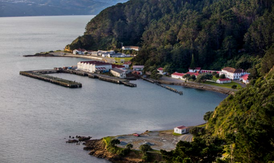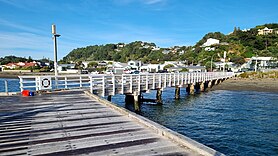Wharves in Wellington Harbour
Wharves were built for various purposes – moving fuel, primary products such as timber, wool and meat coming from the hinterland, and other goods and passengers.
Wellington Harbour's first wharves were privately owned, built by businessmen to facilitate movement of goods from ships to warehouses and shops.
[10] By the early 1860s many of these small private wharves were needing repairs[11][12] and were no longer suitable for serving the larger ships that had begun visiting Wellington.
[1] From 1856, Wellington Chamber of Commerce began calling on the provincial government to fund construction of a large publicly-owned wharf that could serve steamers on the Panama route.
[22][23] The seafront from Shed 21 near the railway station to Clyde Quay, which includes Queens Wharf, was handed to Wellington City Council.
[24]: 13 In the 1990s Lambton Harbour Management, a company controlled by Wellington City Council, was involved in developing Queens Wharf as an entertainment area.
[30] In 2009 the Environment Court turned down the proposal, stating that "building a five-star hotel on a public wharf was inconsistent with the sustainable use of natural and physical resources".
Erected in 1945, it was paid for by people who knew Paddy and includes stones from London's Waterloo Bridge, bombed during World War II.
J H Williams had begun a ferry service to Days Bay in 1895, and Wellington Harbour Board wanted to take pressure off busy Queens Wharf.
In 1898, the chief engineer of Wellington Harbour Board suggested construction of a wharf opposite Taranaki Street, to be used mainly for moving coal but also for timber and produce.
[35]: 16–20 One of the notable vessels to berth at the wharf in the years immediately following its construction was HMS New Zealand, the Royal Navy battlecruiser of the dreadnought era.
The design was intended to give the appearance of an ocean liner and included customs and immigration facilities, a restaurant, café and waiting lounges.
[77] The Board elected to manage the construction of the wharf with its own resources and in 1923 reported that this had achieved a saving of 19% compared with the lowest tendered cost.
[78] There was a major incident in June 1936 when the inter-island ferry TSS Wahine collided with the wharf while entering the port in dense fog.
[83] In 1928, the Harbour Board announced a decision to procure and install a floating dock with a lifting power of 15,000 tons, to be used for ship repairs.
[86] It left the Tyne on 15 July 1931 and was towed for five and a half months at sea over a route through the Suez Canal,[87] covering 21,000 km (13,000 mi),[88] and arrived in Wellington Harbour on 28 December 1931.
[95][96] One of the more notable incidents associated with the floating dock during more than 50 years of service was the repair of the trans-Tasman liner MS Wanganella after it struck Barrett Reef while entering Wellington Harbour in January 1947.
In 2020, following two years of discussion with stakeholders, Greater Wellington Regional Council announced that it had chosen Kaiwharawhara as its preferred site for a new wharf and ferry terminal.
The plan includes a wharf about 250 m (820 ft) long, a ferry terminal building, changes to road, rail and pedestrian access, and marshalling and loading areas.
In December 2023, the new Finance Minister, Nicola Willis, declined extra funding to Kiwirail for its proposed new ferries and terminal infrastructure, and the project stalled while the parties involved considered their options.
Apart from benefitting day trippers, the wharf also improved access to bays on the eastern side of the harbour, which led to an increase in land values.
[126] Engineers have cautioned against demolition of the wharf because it is possible that disruption of the piles might cause major damage to the Waiwhetu Aquifer which supplies almost half of Wellington's fresh water.
[132] A 2019 report published by the Wellington Lifelines Project included an observation that following a major earthquake:[133]: 31 Fuel is critical to run generators, earth-moving plant and for the transport of residents around the region.
[136] The current small wharf, built around 1948,[137] is used by visitors to the island, including East by West ferries which has a regular service for tourists.
[144]In 1886, the Crown took over land at Shelly Bay for defence purposes and in the following years it became the site for an anti-submarine mine depot which included a wharf.
[148][149] Shelly Bay was the site of a proposed major residential development, but the project was cancelled in September 2023, and the land sold to Peter Jackson and Fran Walsh.
[153]: 88 A small jetty was built at Evans Bay in 1951 to serve a short-lived international flying boat service, at what is now Cog Park.
These could be detonated from the shore, so a tide gauge was erected at the wharf for accurate measuring of the depth of the water between the mines and a potential target vessel.
[163] In 2021 Wellington City Council closed the wharf for 18 months for major repairs,[164] and when it reopened East by West Ferries stated that they would no longer offer a service to Seatoun.
[165] The ferry company cited "increased running costs, passenger volumes, and scheduling issues" as the reason for the cancellation, saying that only one of their boats was able to berth at Seatoun in all tides.


















